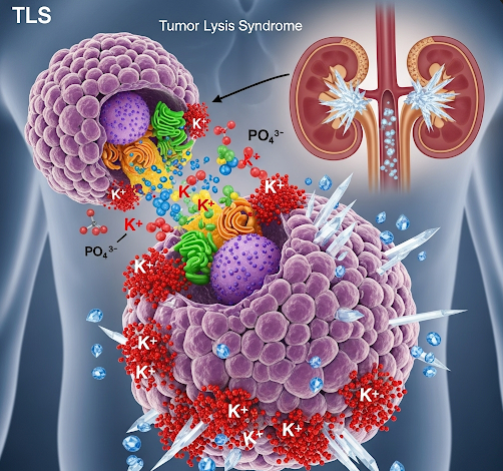Overview
Tumor Lysis Syndrome (TLS) is a potentially life-threatening metabolic complication that occurs when a large number of cancer cells break down rapidly, releasing their intracellular contents into the bloodstream. This sudden release of potassium, phosphate, and nucleic acids can lead to electrolyte imbalances, kidney failure, and cardiac arrhythmias. TLS is most commonly associated with rapidly growing cancers such as leukemia, lymphoma, and certain solid tumors, particularly after chemotherapy, radiation therapy, or targeted cancer treatments. South Korea provides advanced oncology services, intensive care monitoring, and preventive protocols to manage TLS effectively, minimizing morbidity and mortality.
What is Tumor Lysis Syndrome?
Tumor Lysis Syndrome is a metabolic emergency resulting from the rapid destruction of malignant cells. When cancer cells die, their contents, including potassium, phosphate, and nucleic acids, are released into the bloodstream. The accumulation of these substances can lead to:
- Hyperkalemia: Elevated potassium levels causing cardiac arrhythmias
- Hyperphosphatemia: High phosphate levels, potentially leading to calcium phosphate deposits
- Hypocalcemia: Reduced calcium due to phosphate binding, causing muscle cramps, tetany, or seizures
- Hyperuricemia: Increased uric acid from nucleic acid breakdown, risking kidney damage
TLS can occur spontaneously in patients with large tumor burdens or shortly after initiating cancer therapy. In South Korea, hospitals equipped with oncology and critical care units are prepared to detect and manage TLS promptly.
Symptoms
The clinical presentation of TLS can range from mild to severe, depending on the extent of metabolic disturbance. Common symptoms include:
- Nausea and vomiting
- Fatigue and weakness
- Shortness of breath
- Muscle cramps, spasms, or tetany due to low calcium
- Irregular heartbeats or palpitations from hyperkalemia
- Reduced urine output or dark-colored urine indicating kidney involvement
- Confusion, dizziness, or seizures in severe cases
Early recognition of these symptoms in Korean medical centers allows for rapid intervention, reducing the risk of life-threatening complications.
Causes
TLS is primarily caused by rapid tumor cell breakdown. Contributing factors include:
- Chemotherapy or radiotherapy: The most common trigger, especially with high tumor burden
- Targeted therapies or immunotherapy: Can also cause rapid tumor cell death
- Spontaneous TLS: Rare, occurring in aggressive cancers even before treatment
- Large tumor burden: High numbers of cancer cells increase the risk of metabolic overload
- Pre-existing kidney dysfunction: Reduces the body’s ability to clear excess electrolytes and uric acid
Understanding these causes helps Korean oncologists implement preventive strategies before treatment initiation.
Risk Factors
Certain patients are at higher risk of developing TLS:
- Patients with high-grade hematologic malignancies (e.g., acute lymphoblastic leukemia, Burkitt lymphoma)
- Large tumor masses in solid tumors
- Pre-existing kidney disease or impaired renal function
- Dehydration or reduced fluid intake prior to therapy
- Elevated baseline uric acid or electrolyte abnormalities
- Age extremes, particularly pediatric and elderly patients
In Korea, high-risk patients are closely monitored before, during, and after cancer therapy to prevent TLS.
Complications
If untreated, TLS can lead to severe and potentially fatal complications:
- Acute kidney injury: From uric acid crystals and calcium phosphate deposition
- Cardiac arrhythmias: Hyperkalemia can cause life-threatening irregular heartbeats
- Seizures and neuromuscular complications: Due to hypocalcemia
- Multi-organ failure: Severe metabolic disturbances may lead to liver, heart, or brain dysfunction
- Death: TLS is a medical emergency, and delayed management increases mortality
Prompt recognition and treatment in Korean hospitals dramatically reduce the risk of these complications.
Prevention
Prevention is a key component of TLS management, especially in high-risk patients:
- Hydration: Aggressive intravenous fluids before and during therapy to promote renal clearance
- Medications: Allopurinol or rasburicase to reduce uric acid accumulation
- Monitoring: Frequent measurement of electrolytes, kidney function, and uric acid levels
- Adjustment of therapy: Modifying chemotherapy dosing schedules in high-risk cases
- Patient education: Advising patients to report symptoms such as reduced urine output, palpitations, or muscle cramps immediately
Korean oncology teams follow strict preventive protocols to minimize TLS incidence.
Treatment Options in Korea
TLS management in South Korea involves a combination of supportive care, medication, and critical care monitoring:
Diagnosis:
- Laboratory tests for potassium, calcium, phosphate, and uric acid levels
- Kidney function tests, including serum creatinine and urine output monitoring
- Electrocardiogram (ECG) to detect cardiac abnormalities
- Imaging if needed to evaluate tumor response and organ involvement
Medical Treatments:
- Fluid replacement: Intravenous hydration to prevent renal failure
- Medications:
- Allopurinol: Reduces uric acid formation
- Rasburicase: Breaks down existing uric acid rapidly
- Electrolyte management: Calcium, phosphate binders, or potassium-lowering therapies
- Dialysis: In severe cases with kidney failure or uncontrolled electrolyte disturbances
Supportive Care:
- Continuous monitoring in oncology or intensive care units
- Cardiac monitoring for arrhythmias
- Symptomatic relief for nausea, vomiting, and pain
Follow-up:
- Regular laboratory tests to ensure metabolic normalization
- Adjustments in chemotherapy protocols based on TLS risk
- Ongoing patient education on recognizing early symptoms of recurrence
South Korean hospitals integrate oncology, nephrology, and critical care teams to provide comprehensive, multidisciplinary TLS management, improving survival rates and patient outcomes.













